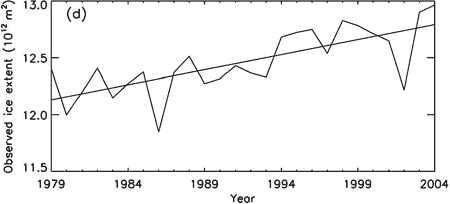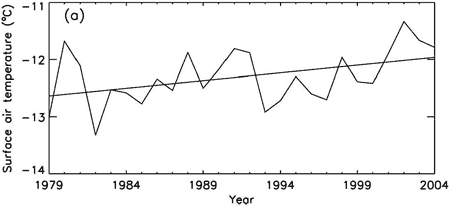Why is Antarctic sea ice increasing?
Posted on 2 April 2009 by John Cook
While Arctic sea ice loss has shown dramatic decline over the past few decades, Antarctic sea ice has shown long term growth since satellites began measurements in 1979. This is an observation that has been often cited by skeptics as proof against global warming. However, in all the skeptic articles I've read, not one has raised the crucial question: why is Antarctic sea ice increasing?

Figure 1: annual mean sea ice extent, observed by satellite. Straight line is the trend line (Zhang 2007).
The implicit assumption is that if Antarctic sea ice is growing, it must be cooling around Antarctica. This is decidely not the case. In fact, the Southern Ocean has been warming faster than other oceans in the world. The average global ocean temperature trend has been 0.1°C per decade from 1955 to 1995. In contrast, the Southern Ocean has been warming at 0.17°C per decade. Not only is the Southern Ocean warming, it is warming faster than the global trend.

Figure 2: Linear trend (1979–2004) of surface air temperature over the
ice-covered areas of the Southern Ocean.
So this raises the big question: if the Southern Ocean is warming, why is Antarctic sea ice increasing? The paper Increasing Antarctic Sea Ice under Warming Atmospheric and Oceanic Conditions (Zhang 2007) attempts to answer this question.
The paper uses a coupled ocean/sea ice model to find the predominant reason that sea ice is increasing is due to a decrease in upward ocean heat transport. Eg - less heat is being carried up by ocean convection to melt sea ice. The reason for this is a complex chain of events.
When surface temperature increases, the upper ocean warms and ice growth decreases. This leads to a decrease in salt rejection from new ice. The salinity of the upper ocean falls. Lower salinity and warmer water results in lower water density in the upper ocean. With fresher, less dense upper water, there is now increased stratification of ocean layers which weakens convective overturning. Less ocean heat is transported upwards. This leads to a decrease in ice melting from ocean heat. Hence we observe an increase in net ice production - sea ice increases.
While all that is a bit of a mouthful, it's actually a simplification of the process as there are various feedbacks along the process. Warming air increases upper ocean temperature which affects air temperature through air-sea interactions. Warming temperature leads to increased precipitation which increases sea ice growth. More sea ice means less atmospheric heat can penetrate waters.
The bottom line is the answer to Antarctic sea ice isn't simple - the Southern Ocean is a complex system with a number of factors likely contributing. One factor certainly isn't a contributor - the simplistic explanation that it must be cooling around Antarctica is not the case. Warming is happening - how it affects specific areas is complicated.































 Arguments
Arguments






























When I first read the paper, there was one immediate question I had about his conclusion and it was the first thing I asked Zhang - I'm surprised noone has asked it here yet. I wonder who'll bring it up... :-)